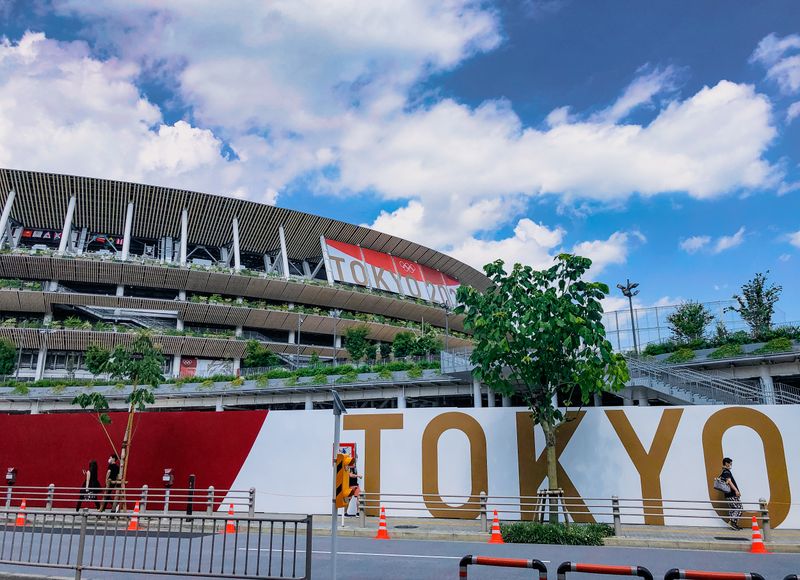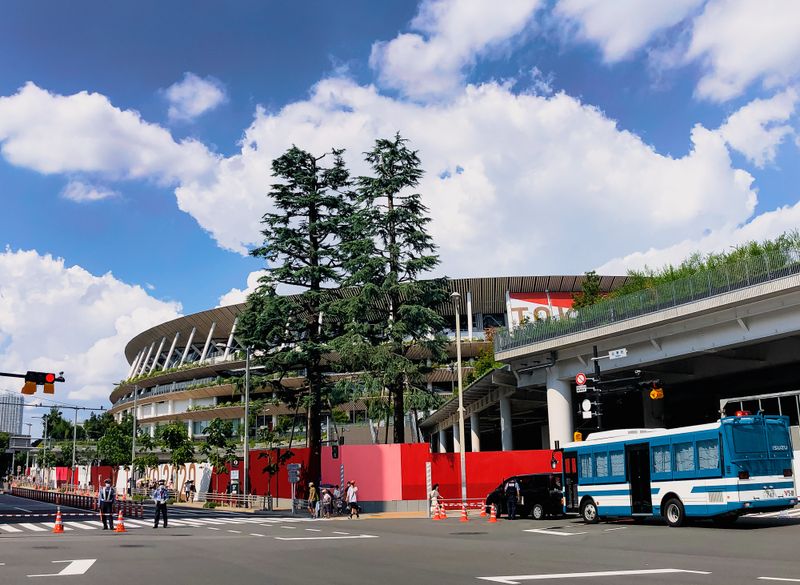Jul 24, 2021
Mood relaxed around National Stadium day after Olympic ceremony

The mood appeared relaxed on the streets around the National Stadium in Tokyo's Shinjuku ward on Saturday, following the opening ceremony of the Tokyo 2020 Olympics the previous night during which protestors gathered outside the stadium to express their opposition to the games.
Searing summer temperatures and a virus emergency were always unlikely to hold back the curious Tokyo public from heading out to get a closer look at the capital's showpiece Olympic venue which was constructed at a cost of 156.9 billion yen. And after games' organizers made the decision to hold the majority of competition behind closed doors due to the pandemic, stolen glimpses from the other side of barriers are about as close as most of the public here will get to seeing with their own eyes what US$1.4 billion can build, at least during game time.



(Police stand guard on Gaien-nishi Dori near the National Stadium on the first full day of Tokyo Olympic competition)
A number of people arrived at Sendagaya Station to view the National Stadium from its west side where the three tiers of the around 60,000 capacity stadium soar above barriers, emblazoned with Tokyo 2020 text and colors, lining a Gaien-nishi Dori closed to vehicular traffic.
Designed by architect Kengo Kuma, the forest-themed stadium is lined with greenery on each of its tiers which almost appeared to glow under the bright sun and clear skies. While temperatures outside the stadium on Saturday were stifling, inside the structure is designed to be cooled by strategically channelled winds and an airflow generated with the aid of 185 fans.


Most people seeking a photo op of the stadium were gathered at its southern end where a model of the five Olympic rings sits in a small park outside the Japan Olympic Museum. A long line of people braved the heat as they waited their turn to be snapped in front of the rings with the National Stadium in the background. Other features of the park include the cauldron from previous editions of the Olympic Games hosted by Japan -- Summer Games Tokyo 1964, Winter Games Sapporo 1972, Winter Games Nagano 1998.

(The Olympic rings make for a popular photo spot outside the Japan Olympic Museum)

(Cauldron from the 1972 Winter Olympics Sapporo)


Next to the park, on Stadium Street, police and what appeared to be members of the Japan Self-Defense Forces stood guard at an entrance on the approach to the stadium.
The area around the New National Stadium is home to a number of projects that are part of the Tokyo Tokyo FESTIVAL -- an initiative from the Tokyo Metropolitan Government and Arts Council Tokyo aimed at promoting arts and culture in the capital in the build-up to the Olympic and Paralympic Games.
Among the Tokyo Tokyo FESTIVAL projects is the pavilion "Tokyo Castle" featuring two castles created by artist Makoto Aida. The castles -- one made of cardboard, the other of blue tarp -- are set up at the southern end of Jingu Gaien Ginkgo Avenue, southeast of the stadium.

(Part of the Makoto Aida-created "Tokyo Castle" pavilion near the National Stadium)
"What I want to emphasize is the opposite of permanence - temporariness, unreliableness, paltriness - as well as the bravery in trying to withstand such characteristics," reads a quote from Aida on an explanatory panel posted in front of his creations. The pavilion is said to be an expression of human resilience and a message of encouragement. "Let's get through this together," reads the explanation, using a phrase that might be jumped upon by those in opposition to the games.




0 Comments